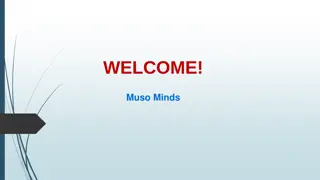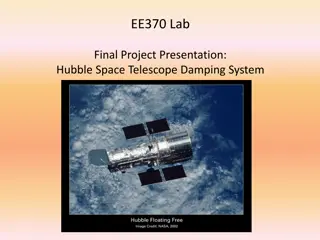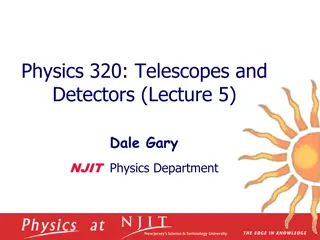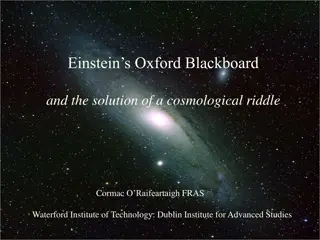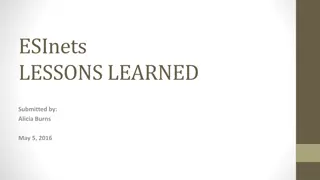Lessons Learned from the Einstein Telescope Design Study
The design study of the Einstein Telescope (ET) provides valuable insights into the evolution of 3G detector concepts, the crucial role of networking structures, and the key elements of the ET Research Infrastructure. Lessons from failures, explorations, and refinements have shaped the development of this groundbreaking project, emphasizing the importance of collaboration, technology considerations, and long-term sustainability.
Download Presentation

Please find below an Image/Link to download the presentation.
The content on the website is provided AS IS for your information and personal use only. It may not be sold, licensed, or shared on other websites without obtaining consent from the author.If you encounter any issues during the download, it is possible that the publisher has removed the file from their server.
You are allowed to download the files provided on this website for personal or commercial use, subject to the condition that they are used lawfully. All files are the property of their respective owners.
The content on the website is provided AS IS for your information and personal use only. It may not be sold, licensed, or shared on other websites without obtaining consent from the author.
E N D
Presentation Transcript
Lessons to be learned from the ET design study Michele Punturo INFN Perugia ET-0005A-16 Dawn Meeting 2016 1
3G concept evolution and ET The Einstein Telescope project born thanks to the fertile environment generated by the EU-FP6 project ILIAS (2004-2008) Integration activity in Underground Physics Networking Working Group WG3, chaired by a GEO (H.Lueck) and Virgo (M. Punturo) delegates, addressed to the future GW detectors: First elaboration of a 3G detector concept Submission of the first EU FP6 proposal (2004) of the design of a 3G GW detector Failed for lack of focus ESF explorative workshop in Perugia (2005) Agreement on the focus on 3G interferometric detector Dawn Meeting 2016 2
Lesson #1: Networking It is crucial to have a well established and official networking structure where to discuss ideas and mediate interests This networking structure needs to be at the same time hierarchical (forum) and open to all the souls This creates the right environment where good ideas can pop-up. Dawn Meeting 2016 3
ET design Study The Einstein gravitational wave Telescope (ET) design study has been submitted in 2007 to the Research Infrastructures EU-FP7 call and we won in 2008 a 3 years long grant of 3M Constrains: European Research Infrastructure conceptual design Effects of the constrains: Simplified approach to the detector(s) and conservative approach to the technologies Sophisticated approach to the infrastructure Request to be capable to work alone Dawn Meeting 2016 4
ET Research Infrastructure Key words: Observatory Beyond a simple detector, but focus on the physics and on the capability to estimate physical parameters Capable to resolve (alone) the polarisations (are only 2?) High duty cycle Redundancy Wide frequency range: Excavate the seismic (and NN) wall at low frequency and keep a good sensitivity at high frequency Several decades lifetime European but International Site seismic evaluation in Europe, but comparisons with USA and Japan underground sites International science team (>200 scientists supported with ET funds) Dawn Meeting 2016 5
Lesson #2: clear mandate A team, in order to realise a good design, needs a strong and clear mandate Constrains should be as few as possible, but clear and well defined Strategic targets should be agreed since the beginning Dawn Meeting 2016 6
Lesson #3: to be scientifically open The ET science team, despite the bureaucratic difficulties, has been a successful tool to spread the ET idea Articles 600 Papers (ArXiv 2009-2015) with Gravitational Wave and LIGO/Virgo/Einstein Telescope/LCGT or KAGRA in the abstract 500 400 300 200 100 0 LIGO Virgo ET LCGT+KAGRA Articles Dawn Meeting 2016 7
ET DS organisation ET Governing council: Institution #1 EGO Institution #2 . ET Executive Board: Management M. Punturo, H. L ck Low Optical Configuration Site and R.I. Science Case Frequency F. Ricci A. Freise J. van den Brand B. Sathyaprakash Dawn Meeting 2016 8
Lesson #4: Organization and links It is crucial to have a team well structured with clear tasks It is important to have an effective link with the institutions, in order to have a stronger mandate and a useful feedback Dawn Meeting 2016 9
3G international collaboration How these lessons can be applied to a 3G international collaboration? Several are the possible schemes, but let try to identify a possible working configuration (personal vision): Dawn Meeting 2016 10
3G organisation Institution #1 GWAC Institution #2 GWIC . GWIC 3G sub- committee Science Team GW community 3G international design executive board and team Management Sites, Detector network, research infrastructures Detector Technologies Science case Dawn Meeting 2016 11
Timing Dawn Meeting 2016 12
AdV+ R&D AdV AdV+ A+/Voyager R&D aLIGO A+ Voyager KAGRA LIGO India eLISA Mission definition Space system development ET R&D ET Infrastructure Technical Design ET Detector Technical Design This process starts in October 2016 ET Observatory & Detector funding ESFRI ESFRI Roadmap Roadmap ET site construction - detector installation & commissioning Cosmic Explorer R&D CE site&detector installation R&D Installation Commissioning Data taking Other 2027 2024 2020 2022 2023 2025 2026 2028 2029 2030 2032 2016 2018 2019 2021 2031 2017
AdV+ R&D AdV AdV+ A+/Voyager R&D aLIGO A+ Voyager KAGRA LIGO India eLISA Mission definition Space system development ET R&D ET Infrastructure Technical Design ET Detector Technical Design ET Observatory & Detector funding ESFRI ESFRI Roadmap Roadmap ET site construction - detector installation & commissioning Cosmic Explorer R&D CE site&detector installation R&D Installation Commissioning Data taking Other 2027 2024 2020 2022 2023 2025 2026 2028 2029 2030 2032 2016 2018 2019 2021 2031 2017


![get⚡[PDF]❤ The Hubble Space Telescope: From Concept to Success (Springer Praxis](/thumb/21514/get-pdf-the-hubble-space-telescope-from-concept-to-success-springer-praxis.jpg)
